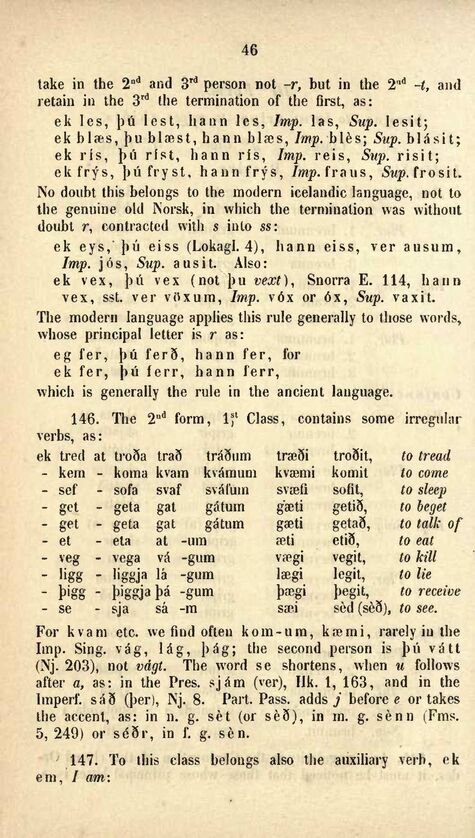
Full resolution (JPEG) - On this page / på denna sida - Part I - Inflection of Words - IV. The Verb

<< prev. page << föreg. sida << >> nästa sida >> next page >>
Below is the raw OCR text
from the above scanned image.
Do you see an error? Proofread the page now!
Här nedan syns maskintolkade texten från faksimilbilden ovan.
Ser du något fel? Korrekturläs sidan nu!
This page has been proofread at least once.
(diff)
(history)
Denna sida har korrekturlästs minst en gång.
(skillnad)
(historik)
take in the 2nd and 3rd person not -r, but in the 2nd -t, and
retain in the 3rd the termination of the first, as:
ek les, þú lest, hann les, Imp. las, Sup. lesit;
ek blæs, þu [[** sic, = ú?: dansk har aksent **]] blæst, hann blæs, Imp. blès; Sup. blásit;
ek ris, þú rist, hann ris, Imp. reis, Sup. risit;
ek frýs, þú [[** sjk aksent: dansk har likedan ú **]] fryst, [[** dansk har ý **]] hann frýs, Imp. fraus, Sup. frosit.
No doubt this belongs to the modern icelandic language, not to
the genuine old Norsk, in which the termination was without
doubt r, contracted with s into ss:
ek eys, þú eiss (Lokagl. 4), hann eiss, ver ausum,
Imp. jós, Sup. ausit. Also:
ek vex, þú vex (not þu [[** ikke ú her: dansk har ú **]] vext), Snorra E. 114, hann
vex, sst. ver vöxum, Imp. vóx or óx, Sup. vaxit.
The modern language applies this rule generally to those words,
whose principal letter is r as:
eg fer, þú ferð, hann fer, for
ek fer, þú ferr, hann ferr,
which is generally the rule in the ancient language.
146. The 2nd form, 1st Class, contains some irregular
verbs, as:
| ek | tred | at | troða | trað | tráðum | træði | troðit, | to tread |
| - | kem | - | koma | kvam | kvámum | kvæmi | komit | to come |
| - | sef | - | sofa | svaf | sváfum | svæfi | sofit, | to sleep |
| - | get | - | geta | gat | gátum | gæti | getið, | to beget |
| - | get | - | geta | gat | gátum | gæti | getað, | to talk of |
| - | et | - | eta | at -um | æti | etið, | to eat | |
| - | veg | - | vega | vá -gum | vægi | vegit, | to kill | |
| - | ligg | - | liggja | lá -gum | lægi | legit, | to lie | |
| - | þigg | - | þiggja | þá -gum | þægi | þegit, | to receive | |
| - | se | - | sja | sá -m | sæi | sèd (sèð), | to see. | |
<< prev. page << föreg. sida << >> nästa sida >> next page >>